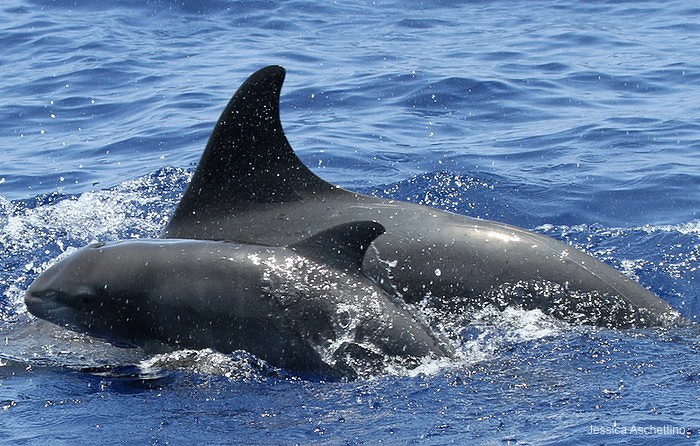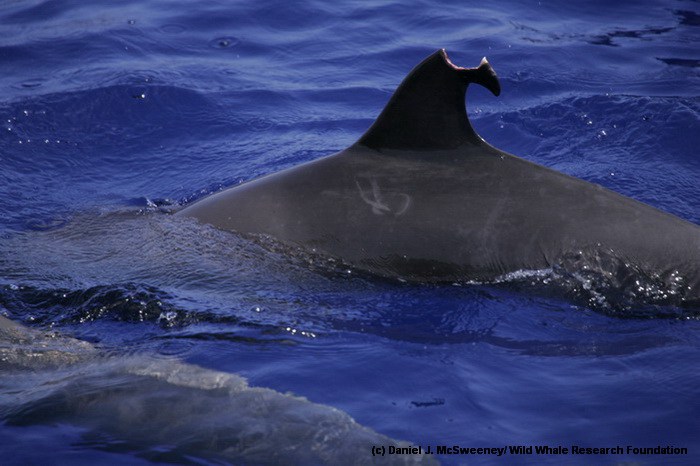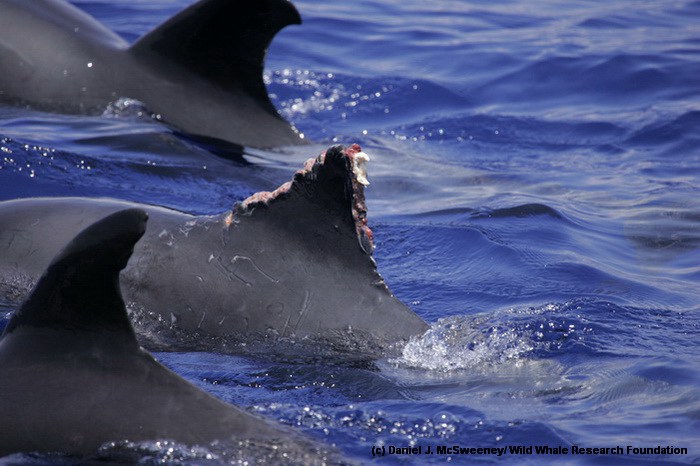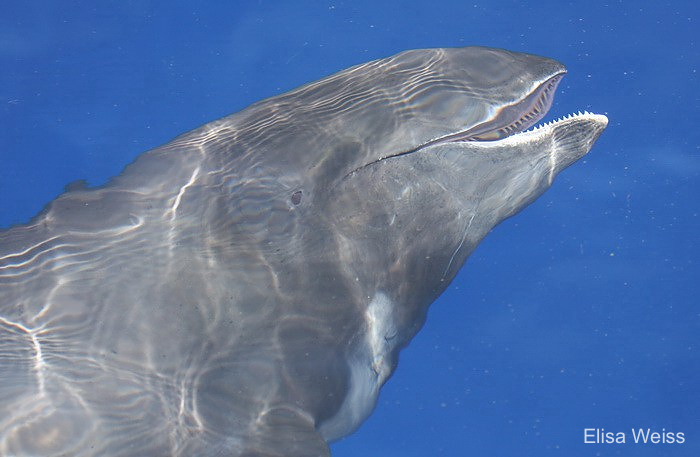Cascadia Research and the Wild Whale Research Foundation are undertaking a 3 week field project off the island of Hawai‘i starting August 11th, 2011. This will be our second field project off the island this year. The primary purpose of the project is to obtain identification photos of a number of species of toothed whales, both for follow up on previously tagged animals, as well as to assess movements and abundance. As well we are collecting biopsy samples for genetic and toxicology studies.
The research team includes Dan McSweeney of the Wild Whale Research Foundation and Jessica Aschettino and Elisa Weiss, as well as a number of volunteers. This work is being funded by the Wild Whale Research Foundation and from a National Oceanographic Parternship Program (NOPP) grant.
The most recent updates are at the top of the page, to start from our first day click here
August 29, 2011 update
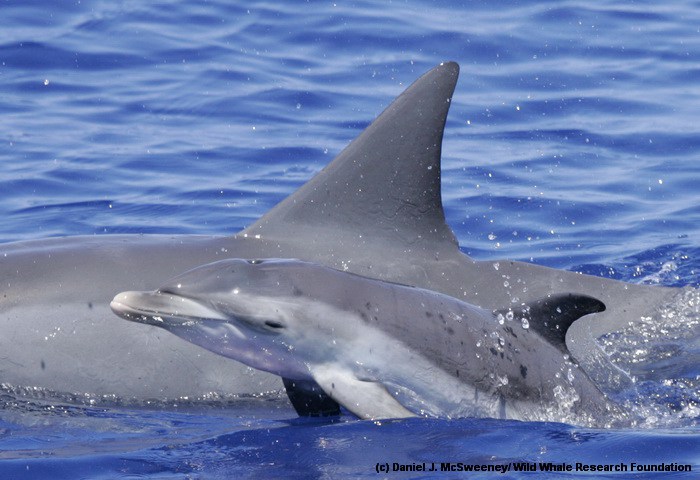
Spinner dolphin next to a neonate, August 29, 2011. Photo by Dan McSweeney. Is the new born dolphin a spinner or a spotted dolphin, or a hybrid of the two? This spinner dolphin was first seen in May 2011 17 kilometers offshore of Kona mixed in with a group of pantropical spotted dolphins (see a photo of it on our May 2011 web page), the furthest offshore we’d ever documented a spinner dolphin in Hawai‘i. The sighting today was also offshore and it was with a group of spotted dolphins – we were able to match it to the May sighting using the notches on the dorsal fin. In the last two days we’ve seen this individual, with the neonate, from ~9 to 13 kilometers offshore. Below are photos of young spinner and spotted dolphins from previous field projects for comparison.
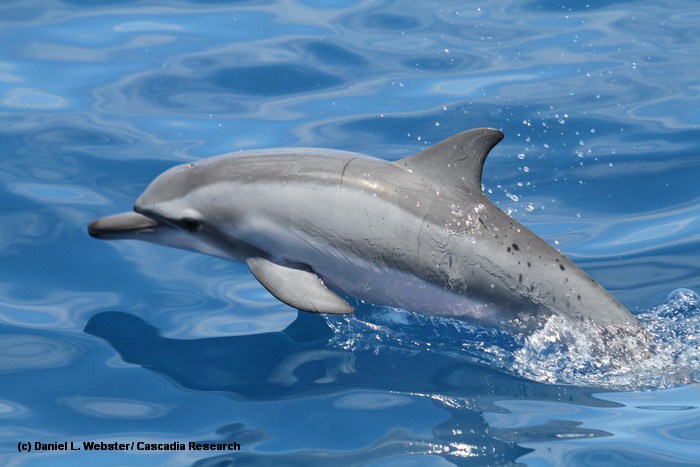
Spinner dolphin neonate seen off Kaua‘i, August 8, 2011. Photo by Daniel Webster. Note the larger and less falcate dorsal fin, differences in coloration, and differences in head shape from the newborn above.
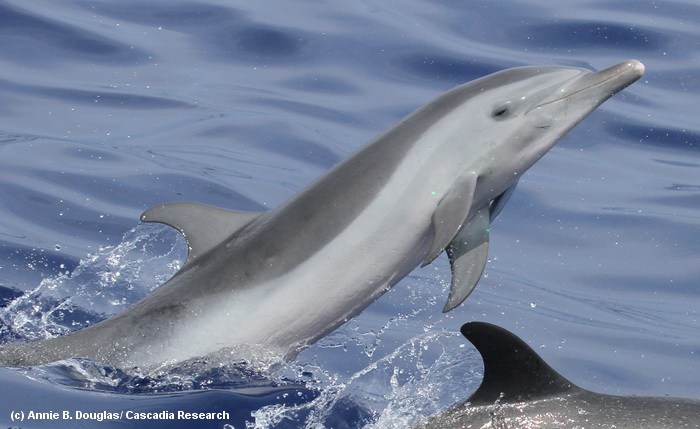
Pantropical spotted dolphin calf, May 11, 2011. Photo by Annie Douglas. The neonate from today most closely resembles a pantropical spotted dolphin, so may either be a case where the neonate was separated from its mother and was just associating with the spinner dolphin, or a possible hybrid.
August 27, 2011 update
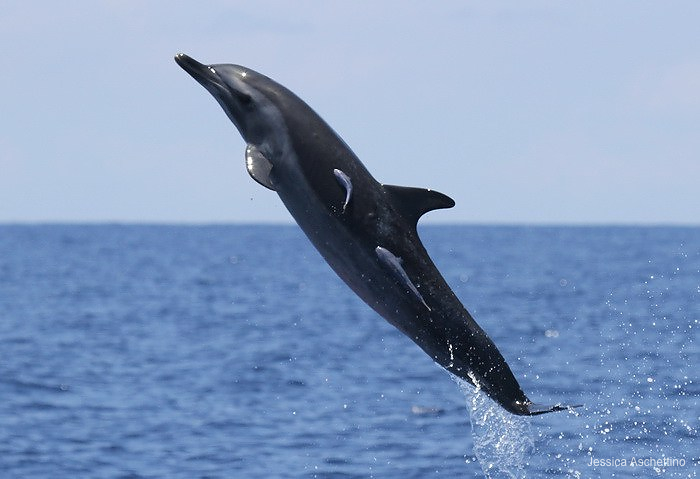
A quiet day on the water today, with our only sighting a group of pantropical spotted dolphins. This individual leaping, probably an attempt to remove remoras. Photo by Jessica Aschettino.
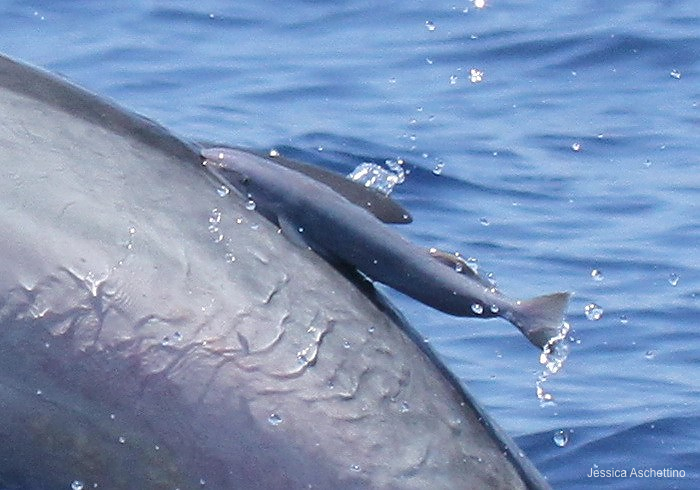
Close up of a remora on a pantropical spotted dolphin, August 27, 2011. Photo by Jessica Aschettino.
August 26, 2011 update
Today we encountered a mixed group of short-finned pilot whales and melon-headed whales. The melon-headed whales were from the Hawaii Island resident population – this is the first time we’ve seen individuals from this population with pilot whales and it was the furthest south they’ve been documented off the island, off of Keahou.
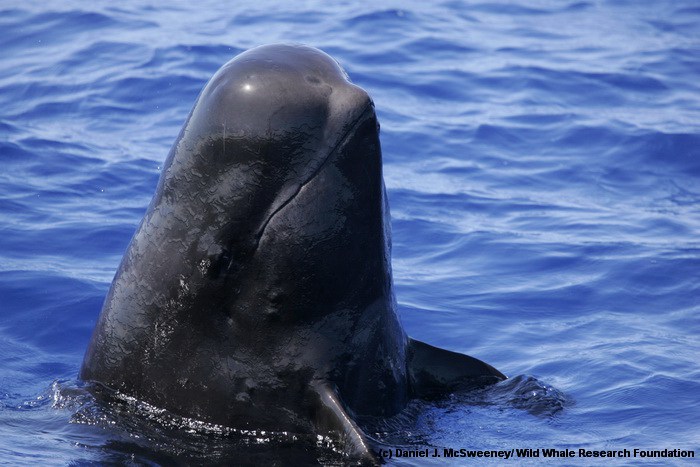
Short-finned pilot whale spyhopping, August 26, 2011. Photo by Dan McSweeney
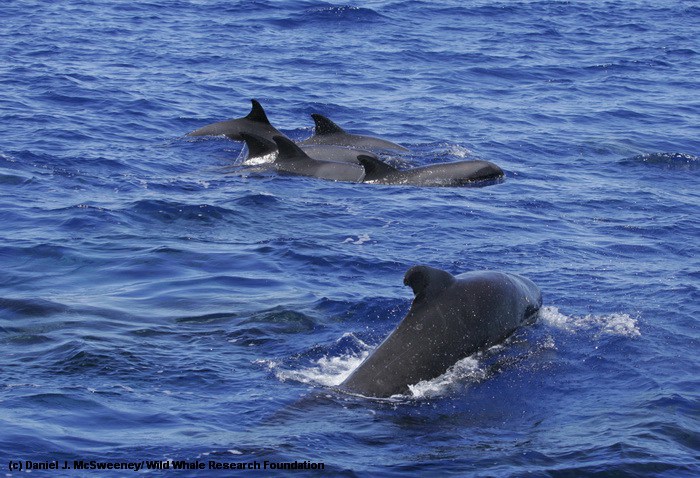
Short-finned pilot whale (foreground) and melon-headed whales (background), AUgust 26, 2011. Photo by Dan McSweeney.
August 25, 2011 update
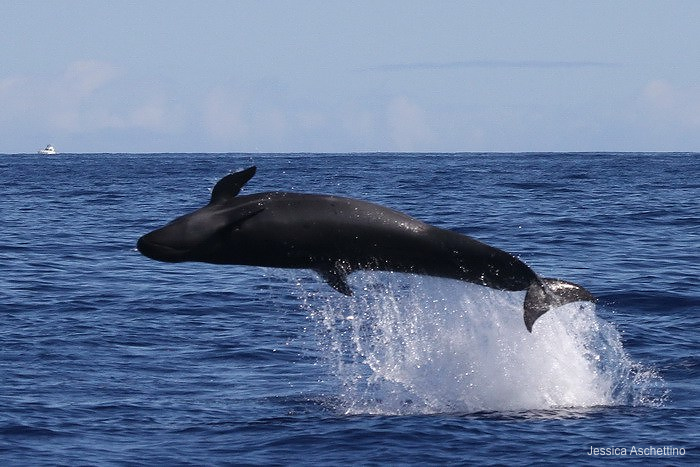
False killer whale leaping, August 25, 2011. Photo by Jessica Aschettino. Today we encountered a different group of false killer whales from the Hawaiian insular population. We were able to identify at least 25 individuals and collected five biopsy samples for genetics and toxicology.
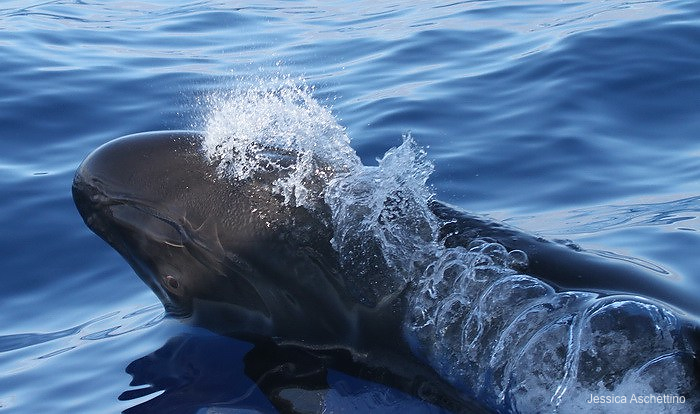
False killer whale, August 25, 2011. Photo by Jessica Aschettino
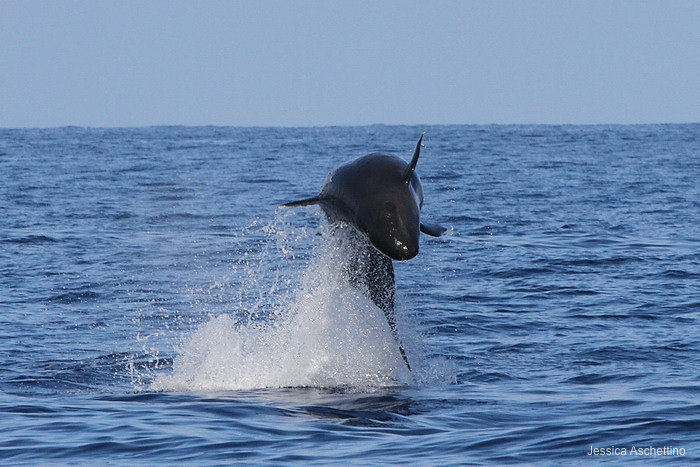
False killer whale leaping, August 25, 2001. Photo by Jessica Aschettino
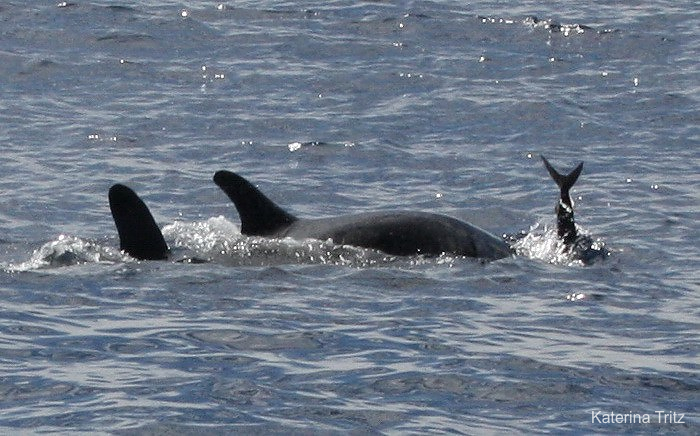
False killer whales with fish, August 25, 2011. Photo by Katerina Tritz
August 24, 2011 update
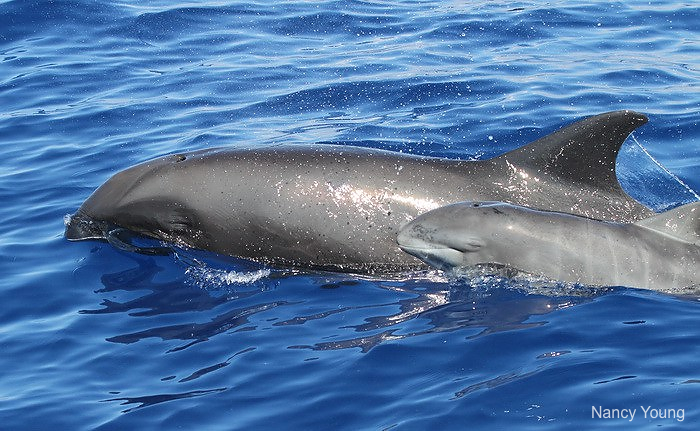
A melon-headed whale mother and infant, August 24, 2011. Photo by Nancy Young. Note the fetal folds on the newborn.
In the last two days we’ve encountered a group of the Hawai‘i Island resident population of melon-headed whales both days. On August 23rd we encountered about 350 individuals, took identification photos of about 200 of them, and collected 8 biopsy samples for genetics and toxiology. Today we encountered about 200 individuals, got photos of about 140 of them, and collected four more biopsies.
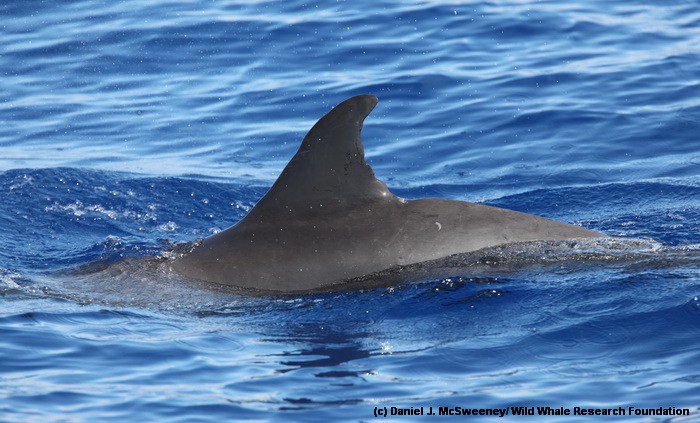
This individual, HIPe1518 in our catalog, was first seen in 2005 and has now been seen on seven occasions since, in 2006, 2008, 2010, and this year. Photo August 24, 2011 by Dan McSweeney.
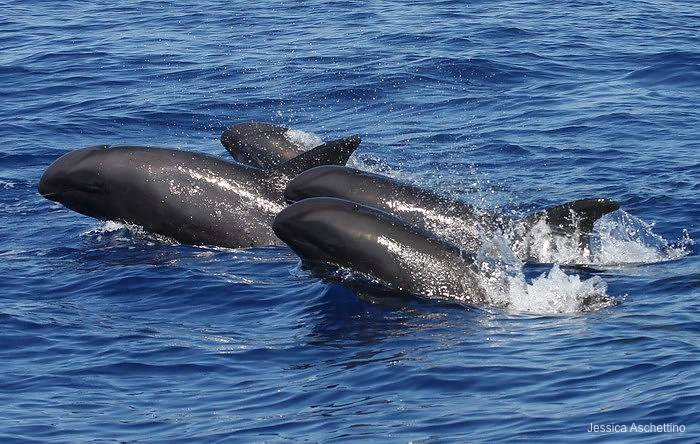
Melon-headed whales porpoising, August 24, 2011. Photo by Jessica Aschettino.
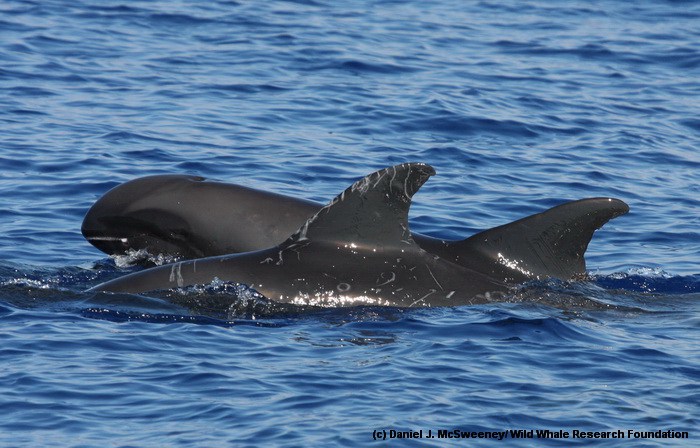
Melon-headed whale with scars, probably from a failed shark attack. Photo by Dan McSweeney, August 24, 2011.

Melon-headed whales from the Hawai‘i Island resident population, August 23, 2011. Photo by Jessica Aschettino
August 22, 2011 update
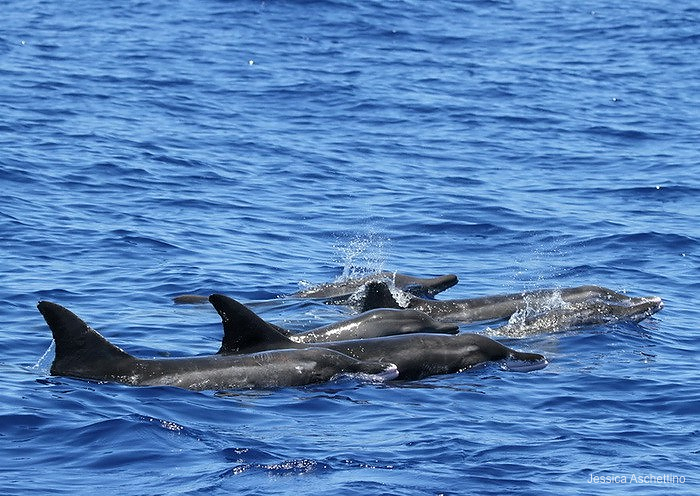
Rough-toothed dolphins, August 22, 2011. Photo by Jessica Aschettino
A good day on the water today, with encounters with three species, two new for the trip. We observed a pygmy sperm whale, a very uncommon species in the area, but unfortunately were not able to get photos. We also encountered another group of pygmy killer whales, and our first group of rough-toothed dolphins for this trip.
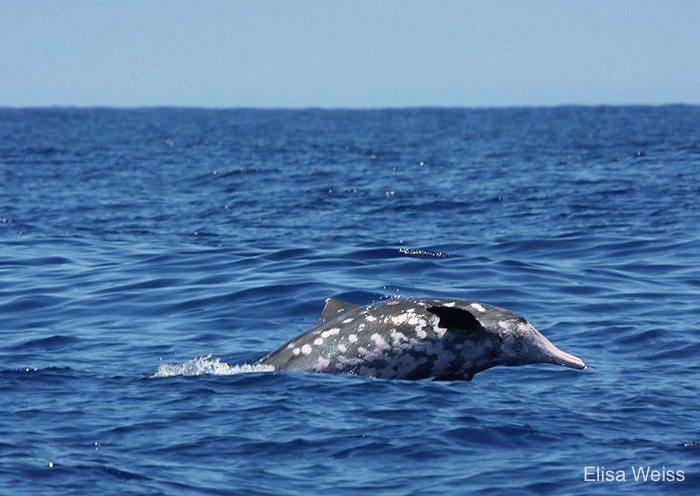
Rough-toothed dolphin leaping, August 23, 2011. Photo by Elisa Weiss. The white scars on the belly of this individual are caused by bites from cookie-cutter sharks.
August 21, 2011 update
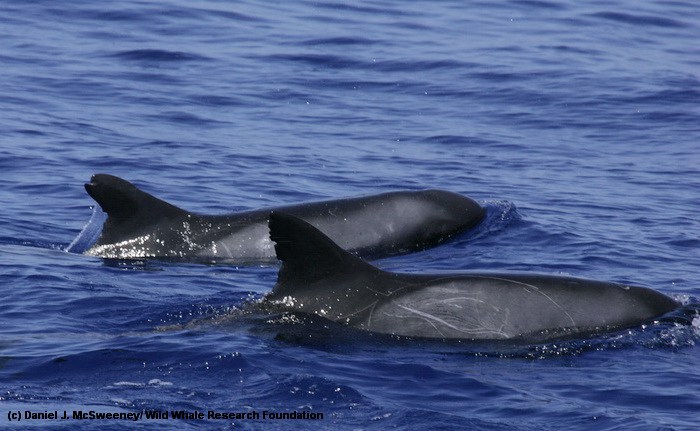
Two pygmy killer whales, August 21, 2011. Today we encountered our 9th species of odontocete for the trip, a group of three pygmy killer whales. Both individuals had been previously documented off the island of Hawai‘i in 2006. Photo by Dan McSweeney. The white linear scars are caused by interactions with other pygmy killer whales.
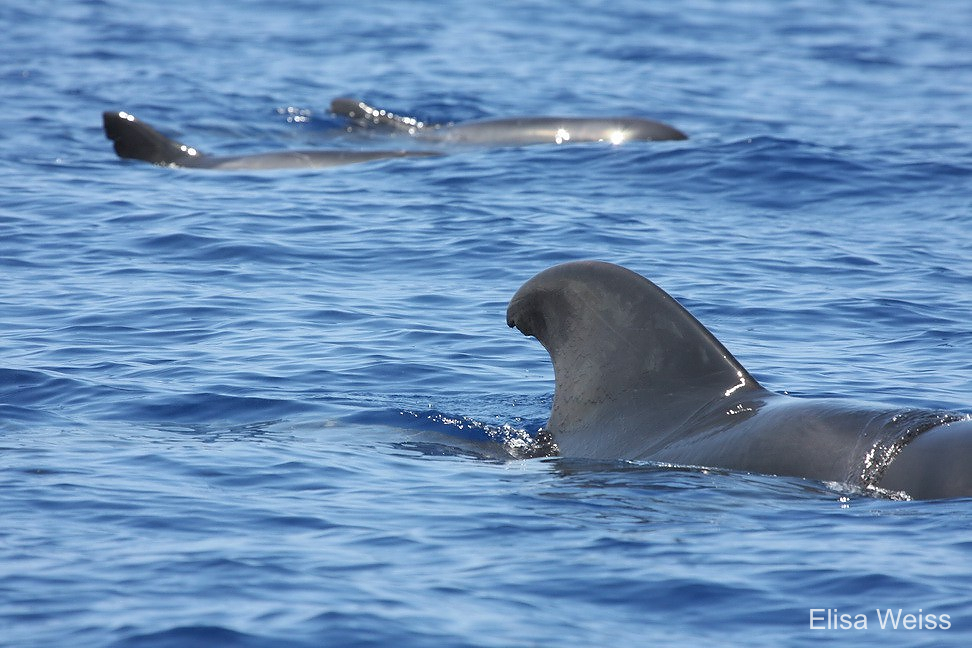
The pygmy killer whales (back left) were with a group of short-finned pilot whales. Photo by Elisa Weiss
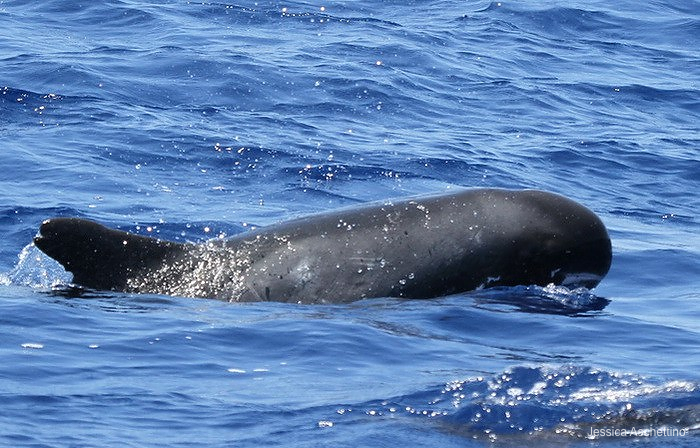
Pygmy killer whale showing the white lips characteristic of this species. Photo by Jessica Aschettino. For more information on pygmy killer whales see our web page for this species.
August 20, 2011 update
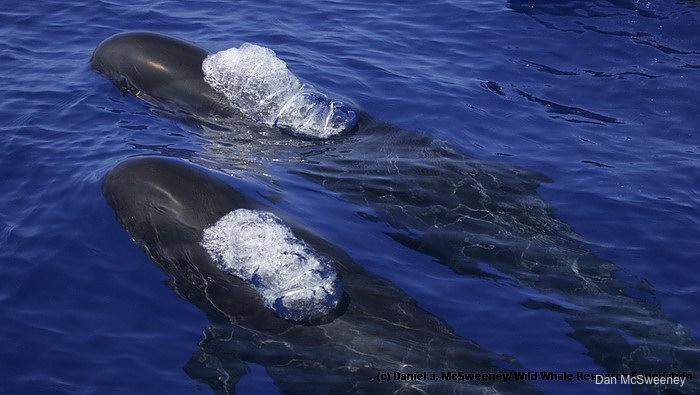
False killer whales off the island of Hawai‘i, August 20, 2011. Photo by Dan McSweeney. Today we encountered our highest priority species for the trip, a group of about 40 false killer whales from the Hawaiian insular population. We recognized many of the individuals present, and were able to obtain identification photos of all them, observed four predation events, and collected 12 biopsy samples for genetics and toxicology studies. For more information on false killer whales in Hawai‘i see our web page for this species.

A very distinctive false killer whale August 20, 2011 – this individual has an injury on the leading edge of the dorsal fin probably caused by interactions with fishing gear. Photo by Dan McSweeney
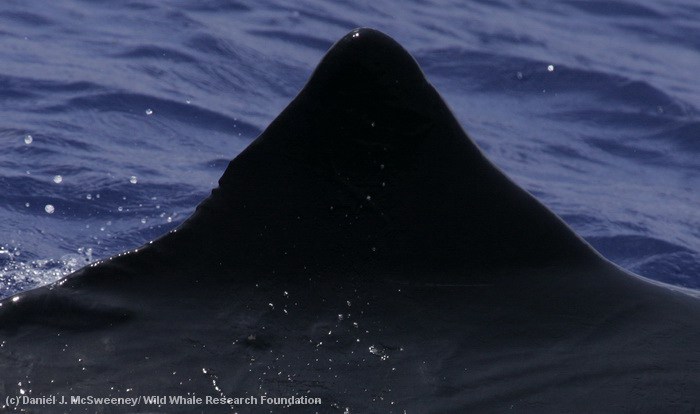
False killer whale seen August 20, 2011, Photo by Dan McSweeney. This individual, HIPc197 in our catalog, was first photographed off the island of Hawai‘i by Dan McSweeney on October 2, 1986, and was seen most recently on August 14, 2010 during our project off the island last year.
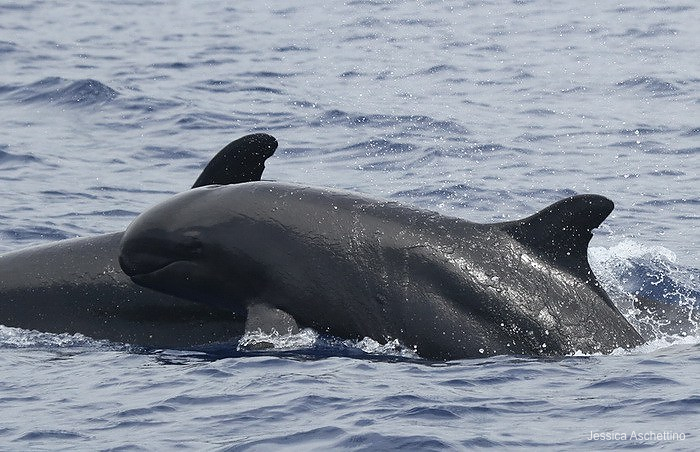
A juvenile false killer whale, August 20, 2011. Photo by Jessica Aschettino
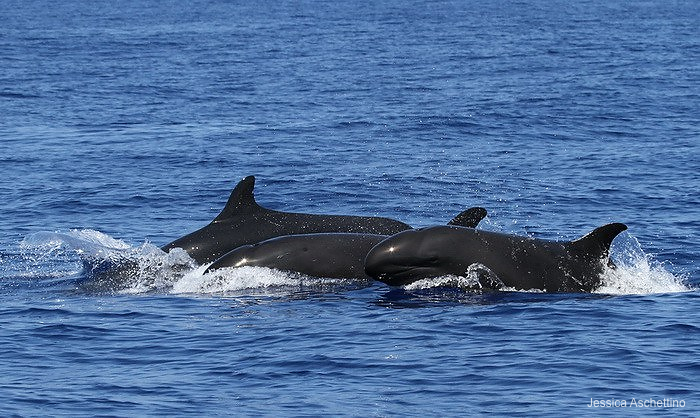
False killer whales off Kona, August 20, 2011. Photo by Jessica Aschettino
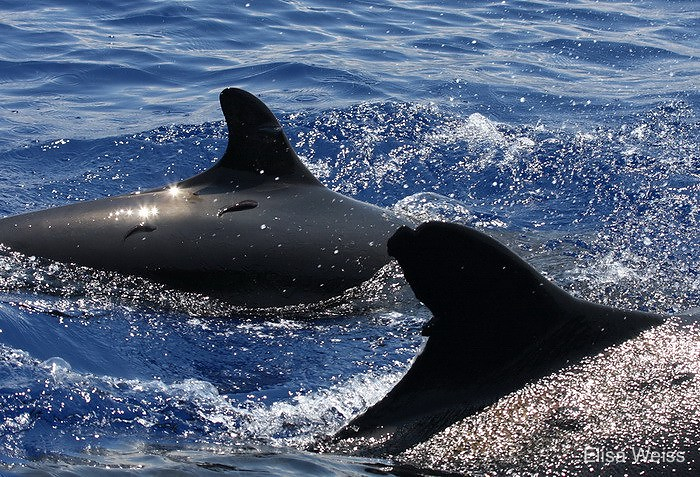
A juvenile false killer whale with two small remoras, August 20, 2011. Photo by Elisa Weiss
August 19, 2011 update
Today we encountered our seventh species of odontocete for the trip, a lone Cuvier’s beaked whale.
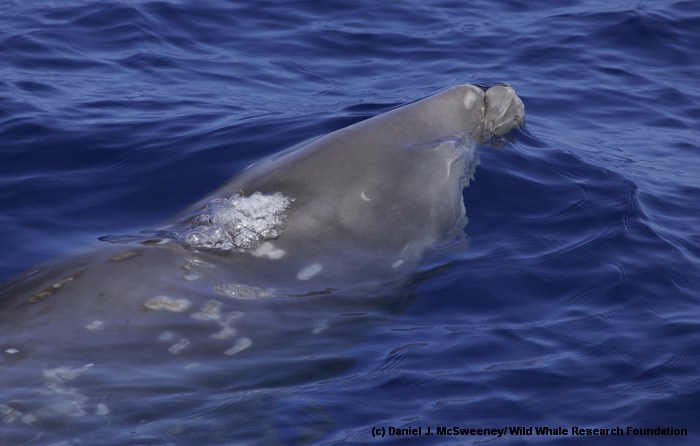
Cuvier’s beaked whale, August 19, 2011. Photo by Dan McSweeney. This individual appears to have a injured or deformed lower jaw. Since there are no teeth erupted from the tip of the lower jaw, this is an adult female. For more information on beaked whales see our Hawai‘i beaked whale page.
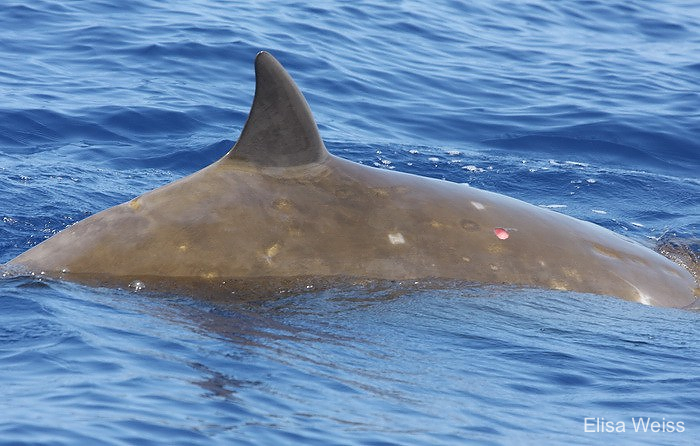
Cuvier’s beaked whale, showing fresh and healed cookie-cutter shark bite wounds. Photo by Elisa Weiss.
August 16, 2011 update
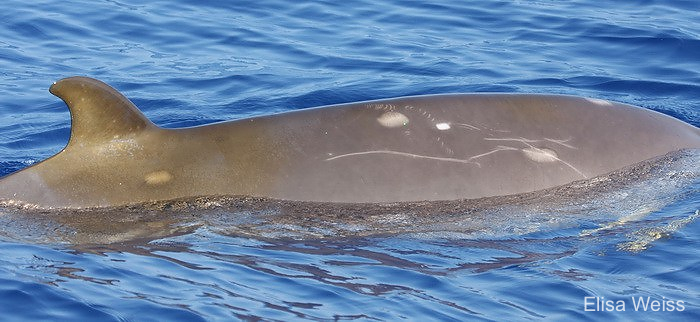
A juvenile Blainville’s beaked whale, August 16, 2011. Photo by Elisa Weiss. Our 6th day of the trip and we encountered our sixth species of odontocete, a lone Blainville’s beaked whale. The white oval scars are from cookie-cutter sharks. The series of small white scars in the middle of the back are probably from an interaction with a different species of toothed whale, while the long linear marks may be from an interaction with an adult male Blainville’s beaked whale.
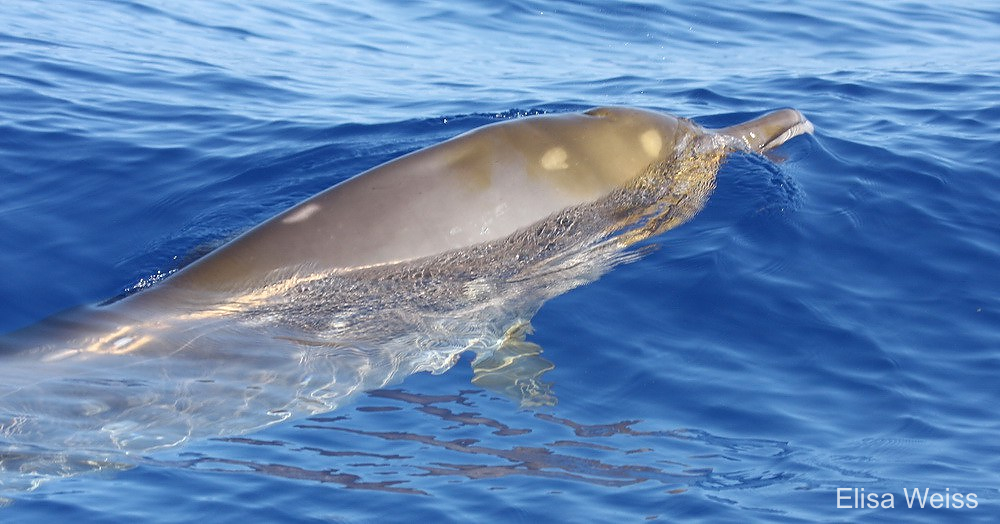
A juvenile Blainville’s beaked whale, August 16, 2011. Photo by Elisa Weiss.
August 15, 2011 update
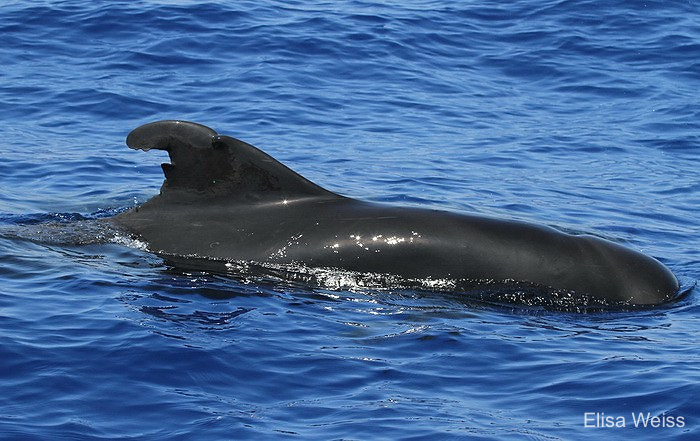
Short-finned pilot whale, August 15, 2011. Photo by Elisa Weiss. Yesterday and today we encountered the same group of about 30 short-finned pilot whales. We were able to photo-ID all of them and obtain laser photogrammetry images of about half of the individuals.
August 13, 2011 update
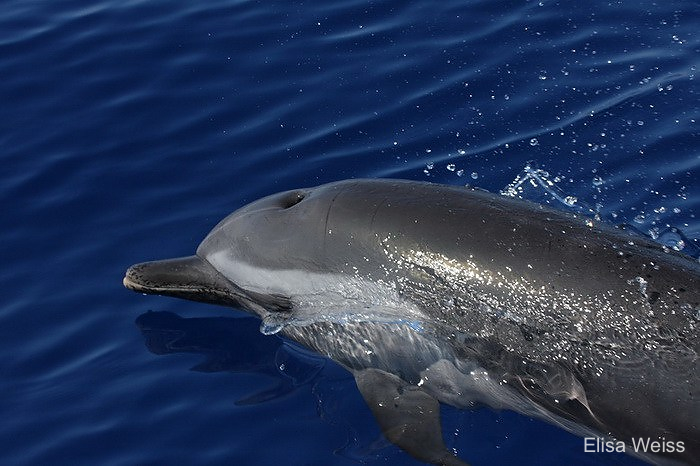
Pantropical spotted dolphin, August 13, 2011. Photo by Elisa Weiss. On April 12th we observed a group of three dwarf sperm whales but were unable to get any photos. Today our only encounter was a feeding group of pantropical spotted dolphins.
Our first day on the water was quite productive, with an encounter with a group of about 400 melon-headed whales. We collected >5,000 photographs and 10 biopsy samples. We recognized a number of individuals present – this group is part of the main Hawaiian Islands population of melon-headed whales, which range throughout the main Hawaiian Islands and offshore. This is our first sighting from this population since April 2009. We also encountered a small group of pantropical spotted dolphins and there were spinner dolphins at the mouth of Honokohau Harbor as we left this morning.
Melon-headed whale mother and infant, August 11, 2011. Photo by Jessica Aschettino.
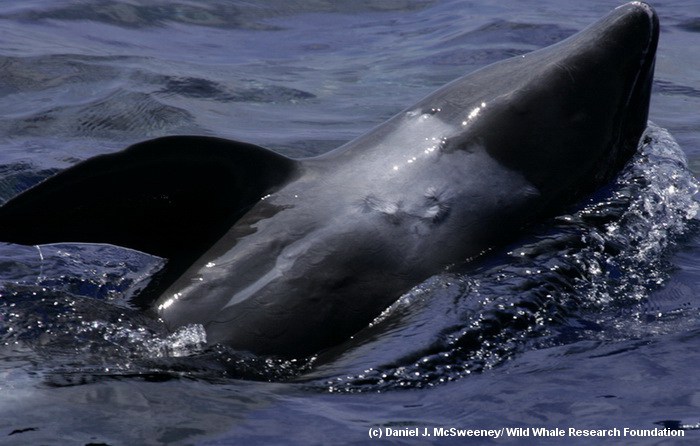
Melon-headed whale, August 11, 2011. Photo by Dan McSweeney.
Melon-headed whale with injury to fin, August 11, 2011. Photo by Dan McSweeney.
Melon-headed whale with injury to fin, probably caused by a shark attack, August 11, 2011. Photo by Dan McSweeney
